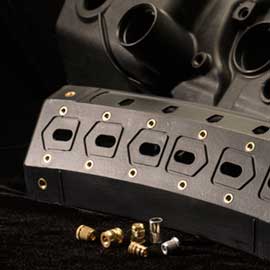For lighter and stronger joints

If a structural element is made of thermoplastic material, it is possible to press a threaded metal insert, heated above the melting temperature of that plastic, into the plastic part.
There are many types of metal inserts specifically designed for holding power.
With the increasing need for lighter and stronger structural components, metal inserts are often used where strong connections are required.
Heat staking (metals to plastics) is one of many applications that utilize plastic melting with IH.
Other applications using plastic liquefaction include metal embedding and the production of thermoplastic composites.
Video: IH Heat staking application examples
Advantages of IH
The process of staking metal to plastic must be fast, accurate, and reproducible to avoid quality defects such as flash (melted plastic overflows) and burns.
IH systems limit the thermal energy only to the outer surface where the heat is needed to melt the plastic.
Long heating cycles result in softening of the internal threads, especially in brass inserts that require heating at lower temperatures.
Utilizing IH power supplies with advanced solid-state technology, IH systems can heat very small areas precisely within manufacturing tolerances without compromising their respective metallurgical properties.
Example of heat staking application
Set up of heat staking
Set the metal insert into the IH coil.
Place the plastic part nearby so that the insert can be inserted immediately.
Apply RF power to the IH coil to heat the insert until it reaches the melting point of the plastic into which it will be inserted.
The hot metal insert is quickly inserted into the plastic.
The plastic around the insert melts and forms a strong bond when the plastic cools to room temperature.
Required Materials
- Metal inserts: Generally made of brass
- Plastic parts
- Temperature sensor (optional): The control system constantly controls the output of the RF power supply to ensure that the heated part maintains the proper temperature while monitoring the temperature. A typical combination is a power supply, heat station, coil, optical pyrometer, and PC.
- Heat source: Ambrell power supplies are best for reliability and reproducibility
Common Problems
Flushing
Extra melted plastic overflows around the insert.
Flushing is problematic in appearance and takes extra time to remove.
Burning
Metal insert gets too hot, changes color, burns plastic around insert, smokes and flashes.
How to solve a problem
- A conical insert is best for this application. This shape has less flashing and good joint strength.
- Do not overheat. Overheating will burn the plastic and reduce joint strength.
- Tightening between the plastic and metal insert ensures a strong joint.
- The optimum temperature depends on the melting temperature of the plastic used. Typically in the range of 149-316°C.
- The joint should not be moved for at least a few seconds after joining. The molten plastic needs time to harden.
